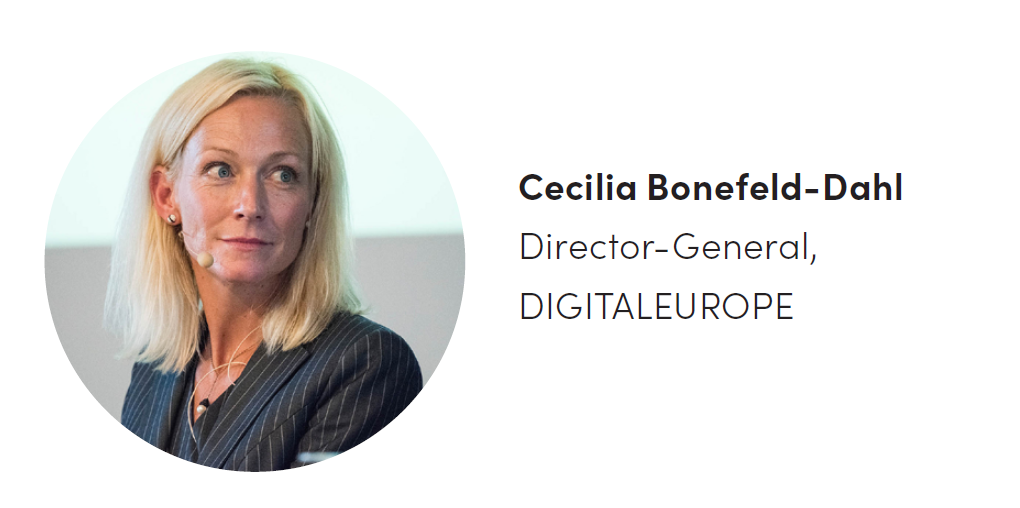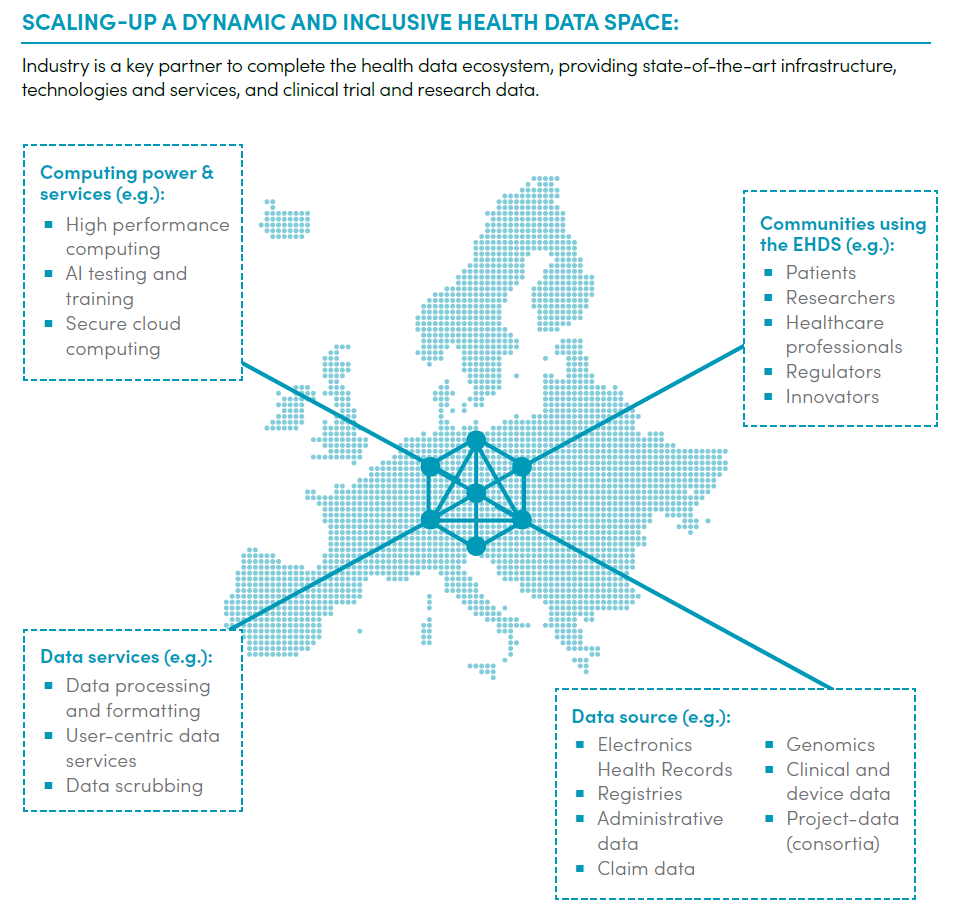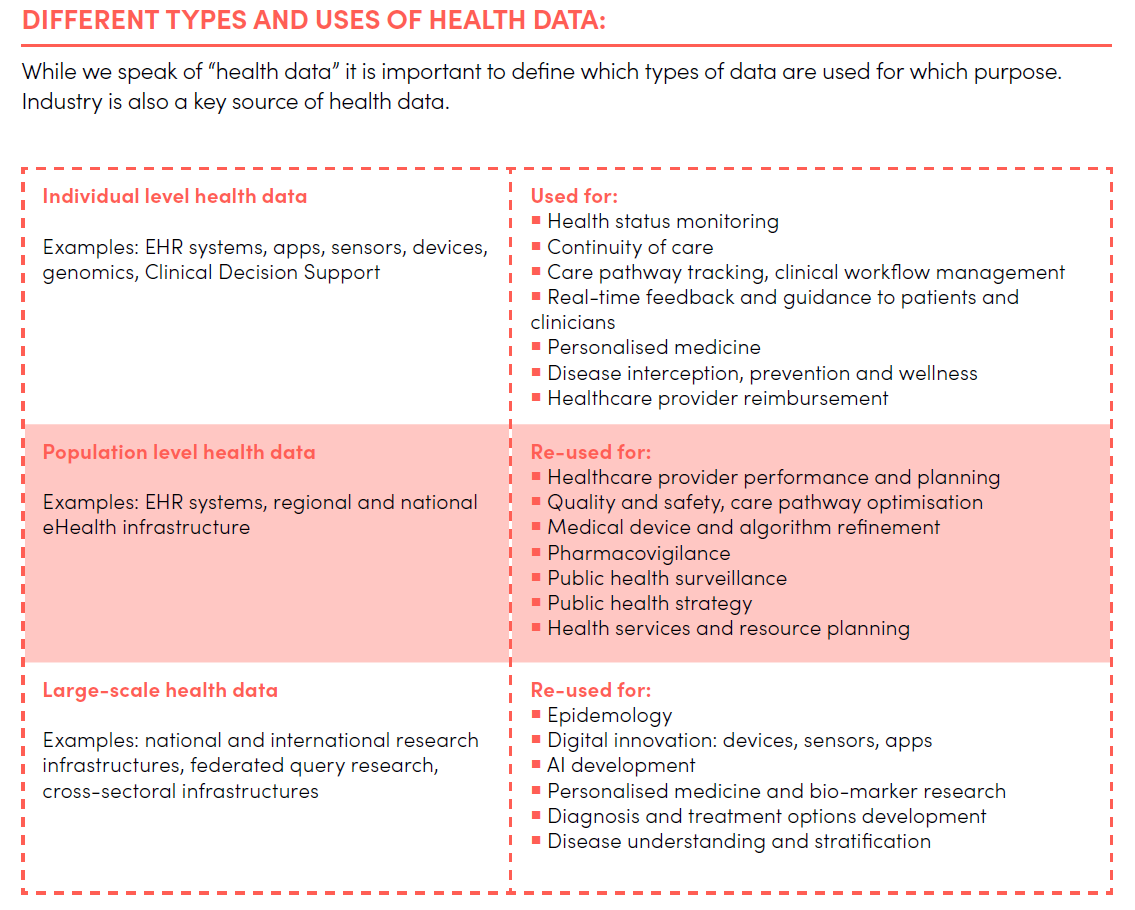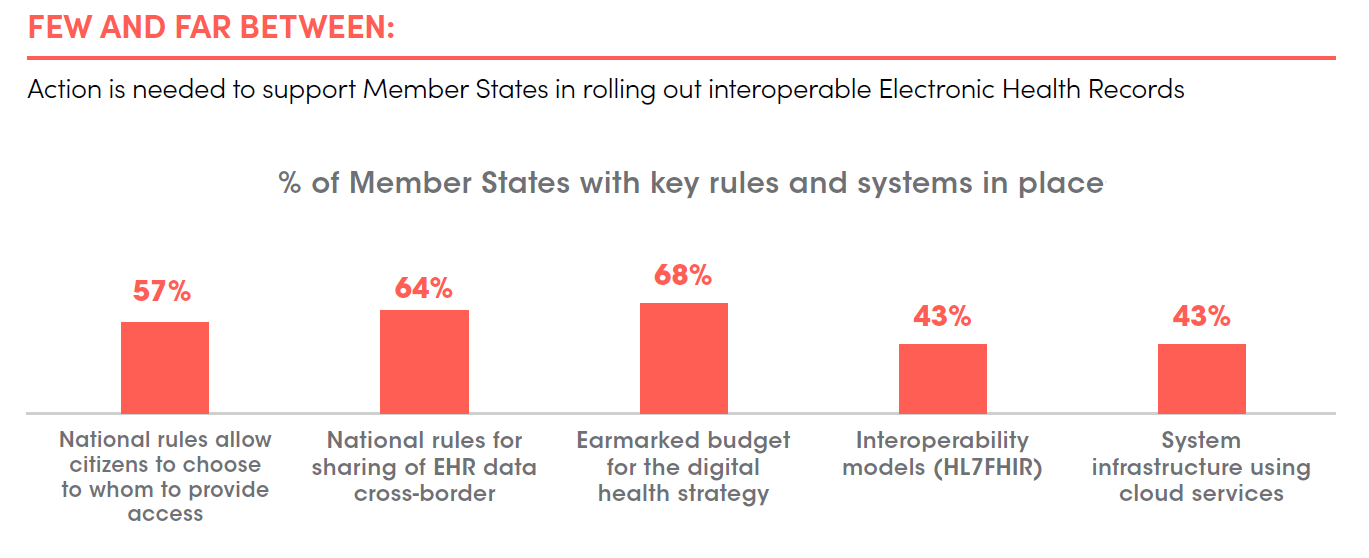A digital health decade: from ambition to action

Foreword
The right to health for all people means that everyone should have access to the health services they need.
There cannot be a Digital Decade for Europe without health innovation. In the next ten years, we must unlock health data to empower patients, beat cancer, find better treatments, support healthcare professionals, and establish more resilient healthcare systems.
Yet, we don’t have the luxury of time. The clock is ticking for an increasing number of patients. Lifespan in Europe is increasing, but so is the number of diseases. Over 4 million people in our continent are diagnosed with cancer every year and this number is expected to reach 5.2 million by 2040.
Tackling these issues will require a secure, trustworthy health data space, facilitating the collaboration between patients and their associations, health professionals, providers, and digital and health companies.
In our view, to reinforce trust, four elements are crucial: demonstrating how health data is used for better outcomes for all, how data infrastructure ensures privacy and security, building on existing successes, and rolling out patient-centric e-health services.
When we get that right, a digital health decade is within our reach. But we must make a concerted push to get it right from the start, sparing no effort in reaffirming Europe as a hub for life-saving innovations.
The good news is, we already have the best and brightest health innovators in Europe. For example, Corti AI, who won DIGITALEUROPE’s Future Unicorn Award in 2020, was recognised by President of the European Commission Ursula von der Leyen for their ground-breaking AI technology using voice recognition to predict heart attacks, developed with patients, healthcare practitioners, providers, and industry.
And, of course, technology and healthcare companies – both experts on data – have upped their game by collaborating, which enabled fast and safe vaccine development.
When we ensure security, trust and awareness in these solutions, everyone benefits – patients, innovators, and the wider society. For instance, we are now dramatically increasing our understanding and detection of genomic and hereditary diseases, thanks to secure, trusted and larger-than-ever genetic datasets.[1]
But we still lack scale and streamlined processes for cross-border use of health data in Europe. This is stalling development of safer and more effective treatments, delivery of more personalised care using real-time data, advancement of trustworthy artificial intelligence in health, and response to public health crises.
This paper is the result of DIGITALEUROPE’s work with our Executive Council for Health and across the wide range of industries we represent to contribute to Europe’s goal to share and use health data for the benefit of all our citizens.
We look forward to helping shape a digital health decade for Europe with policymakers, patients, healthcare professionals and all those affected. Together, we can achieve a truly transformative digital health ecosystem, where collaboration is the fuel for ground-breaking research, trusted health data spaces, and a healthier future for all.


Executive summary
Digital technologies are increasingly crucial for achieving public health goals. This is one of the key lessons from the COVID-19 pandemic we should not forget. Like any other tool, digital technologies are only effective if they are accessible and useful for as many people as possible.
The European initiatives for the Health Union and the upcoming European Health Data Space (EHDS) are key milestones in Europe’s digital health roadmap, as they will shape the ways we collect, share and use health data in each European country and across borders.
We cannot shape a digital health decade without a safe, trusted, and collaborative digital health ecosystem. Driven by our Executive Council for Health, DIGITALEUROPE has brought together the digital and health industries to contribute to Europe’s goal. With this paper, we want to set out an inclusive discussion on trust, equitability, and ethical implications of health data sharing and use, with patients at the centre.
To achieve the goal of a trusted health data space, we kick off by proposing success indicators. We encourage the European Union to agree on targets for digital health, similar to the approach in the proposed Digital Decade strategy. In these 2030 targets, the European Commission has set an EU-wide goal of 100% patients having access to interoperable Electronic Health Records (EHRs).
This is a step in the right direction. In 2021, only 64% of Member States have national rules for sharing EHR data cross-border, only 68% have earmarked budget for the digital health strategy, and only 43% use cloud services as part of their system infrastructure.
But there are further issues hindering a more digitalised Health Union. In Part 1, we identify four pillars needed to successfully encourage trust in, and uptake of, health data sharing and use in Europe:
- Demonstrating benefits for all health communities – including patients and healthcare professionals – and innovators, policymakers and healthcare systems;
- Secure and interoperable infrastructure allowing for the use of a broad array of health data types;
- Leveraging existing health data sharing successes, ensuring that health data can be accessed, shared and used for research and developing new approaches to prevention, diagnostics and treatment;
- Digital health literacy and awareness among patients and practitioners and e-health services designed with patients at their centre, in Member States and across the EU.
In Part 2, we present 15 case studies from our members to illustrate how concrete health technologies, projects from private companies, and partnerships among sectors, academia and patient associations, are building patient-centric e-health services. These are examples of projects that we should scale up in order to achieve a successful, harmonised, and inclusive EHDS.
- Part 1 – Four pillars for trust in the health data ecosystem
- Pillar 1: Demonstrating benefits for all health communities, innovators and society
- Pillar 2: Data protection and security by design
- Pillar 3: Leveraging existing health data sharing successes
- Pillar 4: Rolling-out patient-centric services throughout Europe
- DIGITALEUROPE’s Executive Council for Health
- Our recommendations for key health data policies
- Part 2 – Digital health decade in action: case studies
Increasing access to, and sharing of, health data must be built on trust to encourage all patients, healthcare workers, and other healthcare communities to participate and benefit from it. Trusted e-health systems will improve prevention, enhance patients’ quality of life, and increase access to diagnosis and treatments.
The European Health Data Space (EHDS) proposal has the potential to create a stronger trust framework in Europe. If we get this right, we can truly make a difference.
Measuring progress of the health data space project
In our 2019 manifesto for a stronger digital Europe, and later in our Digital investment plan for Europe’s recovery, we set out a list of success indicators to measure Europe’s digital progress. This same approach has been taken up by the European Commission in its Digital Decade strategy, and should be mirrored for digital healthcare and the EHDS.
We present dual success indicators for all European Member States to achieve by 2030:
should have secure access to their Electronic Health Records and they should be able to manage their own data including across borders. In 2021, these services are not a reality for most and the level of structured and standardised health data is low. We need concrete action to enable mutual recognition of:
-
Easy to use eID services. This service for identification and authentication is needed for enhanced cross-border access to health data and services for safer and continued care.[2]
-
A simple common consent form. In cases where aggregation and anonymisation of patient data is not feasible, and consent is the appropriate legal basis. The process is too complex now.
should have a single access point for secondary use of data. This will require:
-
All EU countries to have a central health data authority. These national entities should provide controlled data services, like healthcare information sharing and analyses. Where things stand, such permitting is fragmented, and centralised governance bodies only exist in 13 Member States.[3]
-
An EU-level entity for secondary use of health data: As a core tenet, the EU-level health data entity should promote the frictionless sharing of health data across Europe in a safe, controlled and privacy-preserving environment.
How we will achieve trust and uptake
The policy-framework and a European strategy for data are only part of the equation. We need to build on strong fundaments to make sure we maintain the level of support needed throughout society to unlock the potential of health data.
Together with DIGITALEUROPE’s Executive Council for Health, we identified four pillars needed to successfully encourage trust in, and uptake of, health data sharing and use:
- Demonstrating benefits for all health communities, innovators and society: We elaborate on patients, healthcare professionals, digital health innovators, policymakers and healthcare systems.
- Data protection and security by design: Much can be achieved by connecting a federated network of controlled data sources to enable research. But this will still require harmonisation of data protection rules, and approaches for de-identification methods through guidelines from the European Data Protection Board.[4] Companies and governments should also collaborate to define or update their Member States’ healthcare data platforms strategies and to select common standards, protocols, and best practices.
- Leveraging existing health data sharing successes: As part of the EHDS, health data sharing infrastructure should include patients, healthcare providers, payers, researchers, and industry. Involving all healthcare communities and setting clear standards from the beginning will ensure the necessary quality, variety, and interoperability of health data. This way, we can leverage existing collaborations for data sharing and analysis.
- Patient-centric services throughout Europe: There are already successful examples of high-quality, transparent and trusted services that are benefitting patients without placing additional burden on them. EU countries should build on what works: for instance, establishing an ‘opt-out’ model, allowing patients to decline secondary use of their health data (rather than actively having to opt in for every research project).[5]
To bring all of this to life, we have gathered 15 projects that our members have been successfully implementing all over Europe, that you can find in Part 2.
The digital and healthcare industries can support this goal with insights drawn on decades’ worth of pioneering work in digital health, including the crucial aspect of managing health data in a secure and privacy-compliant way.
The health data landscape in Europe is currently so fragmented that it’s not immediately clear in what ways the different healthcare communities – patients, workers, researchers – and innovators can use data to realise better health outcomes.
Healthcare providers and industry should collaborate in reaching out to each of these groups, tell the story, listen to feedback and, in doing so, increase mutual trust. This positive and collaborative cycle will ensure that, going forward, e-health infrastructure in the EU and in each Member State can truly meet everyone’s needs.
How will each of these communities benefit from a trusted health data ecosystem?
Patients
- Reducing health inequalities.
To identify and address health inequalities, we need insights. These can be obtained by combining data on clinical care indicators, health behaviour and health outcome measures from various sources, and then mapping this information against factors such as social health determinants.[6]
This knowledge helps identify health disparities among communities that have traditionally been underserved and address them with more accurate interventions.
- Finding solutions for patients with rare diseases.
Digital health has the power to transform how healthcare is provided, not least for patients with rare diseases who are geographically spread out. Scale is key for a better understanding of their disease.
- Improving remote healthcare everywhere in Europe.
Europe’s 2030 goal for 100% access to Electronic Health Records will empower patients with new services to share their data across borders with healthcare professionals and for research.
Connected to a harmonised eID access tool, data sharing services will enable patients to be treated in their own homes or outside of hospitals – wherever it makes sense for them and their care teams.
For example, remote monitoring technologies also bring healthcare into the home and provide access for patients in rural and remote areas, helping to address the care disparity.
- Using data-driven technologies to live longer and healthier lives.
Data analytics and artificial intelligence (AI) solutions in healthcare can not only help detect a disease earlier but also support patients in their treatment, leading to longer and healthier lives.
This is especially important if we consider that, while globally the mortality rate has reduced, the time we spend living with illness or disability has increased. Conditions such as cardiovascular, metabolic, and respiratory diseases are more widespread, as are other severe illnesses such as cancer.
This means that there is growing need for innovative tools to facilitate prevention, earlier diagnosis, treatment decisions and therapy planning.[7] However, data access is fragmented, and its utility is greatly reduced by lack of interoperability. Specific data needs should be defined to support the training, testing and validation of AI, for example to avoid unintended bias.
Data-driven technologies must ultimately meet patients’ needs. Therefore, innovators need large-scale, systematic and regular feedback from patients, including data generated by devices.
- Helping patients make informed decisions about their own health.
The Internet of Things (IoT) is connecting both patients and healthcare professionals. Patients are increasingly using wireless wearable devices such as fitness bands, monitoring cuffs and other connected medical devices for blood pressure and heart rate monitoring. Healthcare professionals are taking advantage of the IoT to monitor, treat and support their patients remotely.
Connectivity also helps care providers and their patients address health issues faster and more efficiently. For instance, data from trusted sources such as environmental agencies can be linked with patient data from a device. This can alert patients of situations which may negatively affect their well-being, such as high pollen count or weather conditions. In this way, patients are enabled to make informed decisions about managing their own health.
Increase in median population age 2019-2050 is projected to be a 4.5 years increase to reach 48.2 years.
Healthcare professionals
- More time for patient care.
Healthcare workers have been under tremendous strain, and this has become all the more clear during the pandemic.
Digital technologies can help healthcare professionals manage their workload, so that they can focus on caring for patients and improve their own quality of life, raising morale while improving quality of care. Digital platforms can also give healthcare professionals far greater and quicker insight into treatment patterns and trends.
While digital does not equal efficiency by default, there are many examples of new technologies meeting the needs of healthcare professionals: for instance, machine learning is already being used to reduce tedious data entry procedures.
- Supporting healthcare professionals in their work.
Digital health also supports healthcare professionals via (remote) access to screening, therapy, and device data. We see examples in artificial intelligence supporting patient health audits by nurses and the clinical introduction of digital pathology. The latter can help pathologists to streamline diagnostic processes, connect a team, even remotely, to enhance competencies and maximise use of resources, unify patient data for informed decision-making, and gain new insights by turning data into knowledge.
- Bridging the gap between data and health sciences.
Up to 70% of health professionals report not using digital solutions due to gaps in knowledge and data analytics skills.
While digital health literacy is also crucial for patients, the importance of standards, medical terminologies and the sharing of technical knowledge in the healthcare sector urgently calls for highly trained data scientists (for example, in genome sequencing), data managers, developers and software engineers who can also understand and navigate this intricate landscape.
- Providing life-long learning in a rapidly developing environment.
Whether carried out at simulation centres or in practice, the education and training of healthcare professionals is an important activity taking place not only at large academic centres but also distributed across primary (day-to-day) and secondary (specialised) care facilities. The fast pace of innovations and the resulting recertification by a growing number of countries increases the need for educational activities, coming at a cost: time, space, funding, human resources and risk for patients.
Final examination is no longer the gatekeeper for healthcare professions: it is just the beginning of a life-long learning process which will need to be documented and evaluated. For that purpose, through data availability, healthcare education can be competitive in term of safety, efficiency, productivity and innovation.
The EU saw an increase in health expenditure between 2014-18 of 13.2%.
Digital health innovators
- Accelerating the development of cures and treatments.
For smaller and larger companies working to improve healthcare and well-being, data-driven processes, automation and machine learning are a game-changer in developing and advancing medicines, medical devices, treatments, and software services.
Without increased access to and use of health data, we would not have seen COVID-19 vaccines being developed in record time. A good example is clinical trials or non-interventional studies – so-called “registry-based studies” – performed by pharmaceutical companies. For their research, they can now use data on patient population collected in one or several patient registries to generate higher quality evidence.
- Reaffirming Europe as a health innovation hub.
The EHDS can be a catalyst for entrepreneurs, companies and research centres to make Europe an attractive place to test and scale-up digital health innovations. Avoiding complex and burdensome processes is essential, especially for small and medium-sized enterprises (SMEs): a single access point to the EHDS for companies is the best solution.
Europe has a long tradition of innovation in health. Helping hundreds of thousands of companies – small and large – to scale and grow will not only bring a better and more diverse offer of healthcare services and products for patients. It will also secure Europe’s competitiveness globally and re-affirm its leadership in openness, fairness and transparency by fostering data sharing between healthcare companies.
- Faster time to market for innovative digital health.
By streamlining and harmonising processes for accessing health data for further processing, the EHDS can accelerate the roll-out of digital health tools while preparing regulators for future technologies. Many digital health solutions available today are not reaching all patients with unmet medical needs due to a lack of regulatory awareness, capacity and data availability in certain areas to enable market access.
- Unlocking real-world data for better evidence.
Data flows can support the analysis of real-world data[8] to complement evidence from randomised clinical trials, optimise clinical trials recruitment, generate evidence to support new drug indications, and support surveillance of drug safety and efficacy post launch.[9]
Such data would also give patients and providers access to near-real-time, post-market information that can better inform their decisions. We already see progress in the regulatory field but need more ambition and inclusion of innovators.[10]
Policymakers and healthcare systems
- Building resilience and preparing for an aging population.
Health spending will increase at a faster pace than economic growth. As chronic diseases are associated with age, the older you grow, the more likely you are to develop at least one chronic condition such as hypertension, diabetes mellitus or rheumatoid arthritis. Chronic diseases are costly to treat, taking up 80% of the €700 billion healthcare budget across Europe.
AI applied in health can support programmes that lead to dramatic reductions in the cost of research and state expenditures.[11] With increased access to and sharing of data, policymakers have more real-time and robust evidence to support policy decisions, which will help ensure that the right resources are directed to the right policy issues at the right time.
- Increasing utilisation in healthcare systems.
According to a McKinsey study, increased data sharing has the potential to save up to €120 billion in the EU’s health sector annually. Data-driven automation has the potential to reduce costly back-office inefficiencies and support clinicians on the front lines, contributing to optimal use of talent.
Digital care is more time-efficient and beneficial to clinic capacity and to reduce pressure on healthcare resources. Digital health can support both complex, at-risk patients receiving tailored care in a clinical setting, as well as serving other patients who may benefit more from high-quality remote care. Waiting times for appointments decline, clinic capacity for assessments increases.
Using digital health tools for disease management can also improve the quality of care while reducing costs through patient rehabilitation outside of hospitals. Greater focus on patient care outside of hospitals and on behavioural health means that we are moving away from centralised clinical models towards delivering care in alternative settings.
- Optimising use of resources and talent.
By 2030, Europe’s demand for healthcare workers is projected at 18.2 million, while today we only have 8.6 million physicians, nurses and midwives. We need to ensure their time is used where it adds most value. AI-based technologies will be crucial to ensure that healthcare systems can keep up with demand.
One such area is imaging power. Radiology professionals are severely stretched due to dramatic growth in demand and increasing complexity of workflows. New AI-based solutions can provide the means to turn the ever-increasing amount of data collected into valuable insights, thus enabling radiology experts to provide more accurate and timely diagnosis for their patients.
Building a transparent and trustworthy network for health data and creating legal certainty are key steps for assuring patients and other healthcare communities that data remains protected, secure, and is handled in an ethical way.
Although multiple health data sharing initiatives exist across Europe, there is a lack of standardisation and scale.
All the technology needed to achieve this is there. Now, the next goal is adopting a common approach and compatible governance models with standardised analytical tools and methods. A well-defined data infrastructure, distributed across Europe, is fundamental to facilitate consistent and secure use and re-use of health data.
There are examples of progress, such as focused funding through the Digital Europe Programme and industry led initiatives (i.e. Gaia-X), that aim to create the foundation for a federated, open data infrastructure based on European values. Europe should tap into the intensifying collaboration between technology and healthcare industries for guidance.
The General Data Protection Regulation (GDPR) provides a solid framework for data protection that needs to be further harmonised to enable health data sharing as intended. To this end, technology and healthcare companies can provide expertise on technical safeguards for data protection practices and support common agreements for use (and re-use) of health data.
For the European Health Data Space (EHDS) to prudently unlock re-use of personal data the connected digital infrastructure must follow the GDPR’s “privacy-by-design” principle – that is, embedding data protection features from its very design.
The EHDS aims to create a data governance model, if supported by the Member States, to solve many privacy-related challenges by advancing federated networks (linking together distributed datasets). This enables a federated research model, allowing the processing of personal data to remain local. Only aggregated information leaves the hospital or institution. This is one of several efficient methods of reducing risks related to data protection.
In short, such a model facilitates connectivity and the use of advanced IT tools while respecting GDPR and intellectual property requirements.[12] However, two major considerations must be taken into account:
- Scale is key for machine learning in a federated space: Federated learning models can gain insights through machine learning without moving patient data. Reduced ability to fully verify the correctness of the scientific results is linked to reduction in robustness, but we can resolve this by gaining access[13] to significantly larger cohorts in real-world-settings, which could result in even more robust algorithms with less bias on certain populations.
- Cloud technology can deliver more with seamless integration: While we support federated networks of data sources, we will achieve even greater levels of insight and benefit for EU citizens when data can be shared and accessed by researchers between Member States. Sharing a federated cloud – combining a community of clouds and services – would enable smaller EU countries to have access to data services that are not available locally. It can be used to securely transfer data seamlessly between data centres in different geographies.
During the pandemic, we have seen a dramatic increase in cyberattacks directed at hospitals and healthcare facilities, already overwhelmed with dealing with the virus.
Cyber risks, threats, and vulnerabilities are multifaceted. It will be difficult to encourage trust in health data sharing and use when large and small breaches take place regularly. They often start locally, say in a regional hospital.
Common standards and protocols are vital for better risk management and cyber resilience in an interconnected health data ecosystem. Establishing such frameworks requires adopting effective cryptography techniques such as encryption, building on stronger cooperation between governments and industry, and supporting initiatives improving cyber hygiene and resilience. There should be collaboration opportunities for security leaders within the same sector to focus on developing effective frameworks and codes.
Another crucial step is for all Member States to define or update their healthcare data platforms strategies, which could be measured through the adoption of data management standards. This would help identify legacy systems – not fit anymore for the current cyber landscape – and opportunities to modernise them. It would also foster healthy competition and bring to the forefront the best possible cybersecurity systems available for data processing in the healthcare setting.
Industry leaders in IT security operate in both the EU and the US. We can achieve the most secure systems by intensifying efforts to solve EU-US challenges for collaboration on health data security.
The European approach to updating healthcare data platform security can take inspiration from success stories where companies and governments have been collaborating.[14] These can be industry collaborations for a common streamlined security framework (for example, such frameworks offer services that comply with the ISO/IEC 27000-series) and by learning from existing efforts to establish national secure health data platforms.
These are the key elements for maintaining a secure data management system:
- Cloud-based enterprise services: These systems answer to cross-sectional IT needs, such as between hospitals, healthcare providers and researchers. They provide secure environments for large-scale data operations aligned to widely used clinical data standards. Interconnected clouds, certified for personalised data, offer greater robustness than individual clusters. Already available cloud services can protect against near all different points of infrastructure vulnerability, including privilege escalation, misconfigurations, weak security posture, unpatched systems, unencrypted data, human error, vulnerable web applications, and malicious insider abuse.
- Building cyber resilience through management and training: Companies share best-practices in developing a proactive information security strategy to properly manage information assets and protect against deliberate as well as inadvertent threats, necessary to safeguard any business and its stakeholders. This involves robust systems and processes, but also regular training and internal guidance, and systematically identifying and tracking risks.
- Identifying evolving cyber risks and developing methods: The cyber risk landscape is dynamic and continually evolving. A security control framework that identifies risks to the EHDS and provides policies and standards as well as a framework to measure, monitor and report on adherence by all participants will foster the transparency and trust needed by Member States, patients and providers. The system should be risk-based and provide for control baselines appropriate to the sensitivity of private information. To this end, IT security providers develop repeatable and vetted technology patterns that implement and monitor cybersecurity principles and operational frameworks to ensure those capabilities are sustaining for all participants in the EHDS and the system.
- Cyber assurance: Assessment and reporting processes for the EHDS and participants will allow for measurement of security effectiveness among participants in the system and control inheritance by participants required to achieve shared levels of security.
To promote trust across borders, we should build on existing frameworks and profiles for research and healthcare delivery, for example, for ensuring ethical and secure conduct.
Promote frameworks and profiles for research and healthcare delivery
In addition to ethical concerns, we need to keep in mind that health data, in order to be shared and used, needs to be of sufficiently high quality for its intended purpose. There are industry standards available that have been developed for those needs.
For instance, robust and ethically sound AI in a health context relies on access to fit-for-purpose quality, high-volume, accurate, sufficiently representative, and properly annotated datasets. These must meet the required standards to demonstrate that, for instance, medical devices or pharmaceutical products are safe and effective to fulfil their intended purpose.
Industry has taken proactive measures that can be expanded and built upon, including:
- Industry good practice: Public and private-led codes of conduct, international frameworks, compliance requirements, and guidelines for ethics and transparency in (clinical) data practices. An example can be found in the Global Alliance for Genomics & Health, producing standards and guidance for data security, ethical concerns and more.
- Improving sound and proven statistical methods: Scientifically and statistically sound methods to help reveal patterns of association or disease causation can be used with unprecedented accuracy, sophistication, scale and speed. Industry has the capacity and know-how to combine datasets, using statistical methods, for new insights at the population, cohort, or personal level.
- Fit-for-purpose standards for health data: Companies with significant experience and expertise with privacy preserving, Findable, Accessible, Interoperable and Reusable (FAIR) and high-quality data provide insights needed to develop common standards, ethical, technical and quality requirements. In the box below you can find examples of data quality characteristics. Industry provides technological solutions to facilitate data processing and reduce delays from data collection to data (re-)use.
- Widely adopted standards and models: While we applaud the progress made with the EU Electronic Health Record Exchange Format (EEHRxF) and x-eHealth exchange format, we should put more focus on reducing data siloes through agreeing on a set of existing standards. Industry is pioneering the roll-out of interoperability standards to normalise cross-sectoral and cross-border data exchange using internationally supported standards. Examples are Fast Healthcare Interoperability Resources (FHIR) developed by Health Level Seven International (HL7), Integrating the Healthcare Enterprise (IHE), and the OMOP Common data Model.
These are examples of data quality characteristics used by researchers today:
-
Accuracy
Data reflects an event as it actually happened.
-
Consistency
Data is consistent across datasets, and over time.
-
Completeness
Data required for a given purpose is present; for example, a health record should contain all pertinent documents with appropriate documentation.
-
Timeliness
Data is updated as an event occurs, such as when a treatment is performed, or results noted.
-
Accessibility
Data is available to authorised persons when and where needed.
-
Interpretability
Patients or users can properly understand the data.
-
Transparency
Data retention and expiration policies are defined and agreed upon.
-
Portability
Data has attributes that enable it to be installed, replaced or moved from one system to another preserving the existing quality in a specific context of use.
Include existing industry-driven collaborations
Both international and European companies are deeply intertwined with the research and SME communities in Europe. Through their cooperation, these communities have the resources (funding, expertise, partnerships with public research and people), the capabilities and the global reach to maximise the societal and individual benefit of increased data access and use.
DIGITALEUROPE’s Executive Council for Health serves as a prime example of the global spread of the digital health ecosystem, covering continents and a network of hundreds of thousands of researchers devoted to finding cures and treatments, working in cutting-edge R&D departments.
Additionally, the EHDS can provide talents in smaller businesses with a European data resource that can help their businesses scale up and demonstrate the value of their innovations.
These are areas where the EHDS can take advantage of these communities:
- Providing clinical trial data: The healthcare industry has a long history of being trusted stewards of data delivering clinical trial results on time (or early) to high quality standards. Many organisations share clinical trial data for researchers because it helps physicians, patients and healthcare providers to make informed treatment decisions. Examples of such initiatives are YODA, Project Data Sphere, TransCelerate, and many more. These projects make sure that when volunteers participate, their data doesn’t go to waste and can be re-used for future research.
- Collaborations between health, tech and academia: There is no need for the EHDS to start from scratch. Data sharing infrastructures are already being built across Europe, such as the raft of IMI Big Data for Better Outcomes projects. Many of these projects already receive substantial European Commission investment and are already well down the road to achieving results for EU citizens and patients. More importantly, the EHDS can make use of the European and international multi-stakeholder communities which have been created and the efforts which have brought together patients, clinicians, researchers and healthcare professionals with data scientists. Building from such projects ensures proper use of Commission funds, avoiding unnecessary duplication and re-invention.
- A broad array of data sources: Health data from both public and private sources can be used, in compliance with data protection rules, in projects aimed at unlocking unique insights for patients, healthcare workers, policymakers, researchers and developers. For example, this could be (in some cases in real-time) data from a medical device or fitness band, patient generated reports, registries and repositories, electronic medical records, insurance claims data, genomic data or even environmental data. Take for instance genomic data; Genomics England[15] has already engaged with industry partners to develop technological solutions for its platform, such as a purpose-built patient choice tool called e-consent.
- Global ecosystems for research: The EHDS creates the potential for Europe to exchange data with other centres of excellence for research internationally. Industry should be seen as a partner to promote cooperation on international data transfers for advancing research to combat pandemics and diseases.

Innovation is only as impactful as the number of people using it. Promoting trust and uptake will trigger a positive cycle, because increased data use will lead to better outcomes. Patient-centric e-health services will empower patients to communicate more easily with their physicians and healthcare providers, and to share feedback with innovators and policymakers.
Harmonised e-Health services across the EU
When Member States develop their health strategies, they must be ambitious, but also in sync with EU frameworks. We need to promote, coordinate and support Europe-wide initiatives to accelerate the level of uptake and to realise interconnected European data spaces. Achieving scale relies on Member States and their respective healthcare ecosystems.
Digital technologies provide solutions for governments that are investing in patient-centric healthcare systems. But in the interconnected digital age, we cannot build digital health infrastructure in 27 different national siloes. The proposed EHDS requires well-defined services that should be fast and reliable.
Broad support and uptake from patients and healthcare workers is vital to ensure they can truly benefit from health data sharing and use. To this end, we must empower everyone with higher level of digital health literacy, whether it’s by helping patients better understand the different types of health data and their use, or by supporting healthcare workers with trainings, digital health skills and shifting to new ways of working.
Boosting awareness of the different types of health data and their use
It will be important to distinguish between fact and fable. We can foster knowledge and trust by maintaining public transparency on data access conditions and rules. This requires efforts in raising awareness, publishing approved uses of data, and promoting success stories and concrete benefits to society.
Most importantly, patients need to understand for what purposes their data is being used, whether it is for improving care, population health, or scientific research.
For instance, gleaning off insights from large, aggregated datasets has significantly different implications than using and combining datasets for personalised treatments, but both are crucial to the development of better healthcare. We support initiatives like the Data Saves Lives or Understanding Patient Data.
A framework of trust starts with the groundwork, but it should be clear from the start what needs and uses will arise in the future. We should clearly define and spread awareness on which health data uses have particular requirements and which have a high impact and should be prioritised. You can find a helpful overview below.

Investing in the transformation of healthcare organisations
At the organisational level, effective change management and much more funding from all levels of government are needed throughout healthcare systems to ensure the momentum towards digital, initiated by the COVID-19 pandemic, is not lost. For instance, there are indications that telehealth adoption, after an initial increase during lockdowns, has slowed down.
This will require enhancing digital skills and literacy for healthcare practitioners and patients. One successful example is Portugal’s Cascais hospital, that created new roles to act as champions in introducing technology to staff and building digital skills internally, such as Chief Medical Information Officer, Chief Nurse Information Officer, and Chief Pharmacy Information Officer.
One the other hand, we must not forget about educating data scientists and developers on the needs of patients, regulators, and healthcare practitioners.[16] This is also relevant for the application of AI to clinical practice. Key challenges include those intrinsic to the science of machine learning, logistical difficulties in implementation, a lack of scale, but also consideration of the barriers to adoption as well as of the necessary sociocultural or pathway changes.
DIGITALEUROPE’s Executive Council for Health
In July 2021, DIGITALEUROPE launched its Executive Council for Health to bridge the gap between business and policy expertise, and to advance the digital transformation of the health industry. The Council – comprising 19 senior executives from leading health and technology companies – encompasses Future Unicorn Award winning small and medium-sized companies (SMEs) and leading firms with many decades of experience in digital health.
The Council members collaborate to provide unique insights to policymakers on how digital can address urgent healthcare challenges. Unequivocally, trust and the roadmap for the European Health Data Space (EHDS) are the first concern, as they are foundational to the EU’s ambitions.
We support the European Commission’s ambition to enable sharing of data for healthcare, create a genuine single market for digital health products and services, increase access to health data for research, innovation, and policymaking, and foster the use of artificial intelligence in health.
To this end, we are aware of our role. Industries can do much to support the integrated network of academia, SMEs and public-private partnerships in healthcare, and therefore we understand our responsibility in fostering trust and support for the EHDS. We invite representatives of patient, clinicians, healthcare providers, regulators, and other groups to engage with us.
Our recommendations for key health data policies
Read our detailed recommendations on our “Digital for Health” page.
DIGITALEUROPE’s key policy recommendations for health data sharing
- Building trust with EU citizens on data sharing initiatives involves structurally demonstrating results on issues that are meaningful to people’s everyday health and life. It needs to be possible for anyone in Europe to see real world outcomes of care and treatment, whilst supporting research for innovations in healthcare.
- The EHDS should align with current and developing legal frameworks. Read our positions on:
- How to make the most of the GDPR for research: There is still too much uncertainty around how health research can be conducted in accordance with data protection rules, and Guidelines from the European Data Protection Board should aim to remove as much of this uncertainty as possible. Resolving these issues is necessary to make the future EHDS possible and successful. Codes of Conduct for health research could be helpful.
- Initial findings on the proposed AI Act: Ensuring consistency and synergies with the EU framework is key. The EHDS should enable trustworthy AI with representative and fit for purpose data.
- Recommendations for the Data Governance Act: The European data economy will be a key driver of the EU’s growth this decade. Our key recommendations are to:
- Prudently unlock re-use of sensitive data.
- Safeguard existing data sharing initiatives.
- Leverage data altruism.
- Keep the framework simple.
- In our response to the consultation on the EHDS we called for the coordinated promotion of system-wide interoperability for both primary and secondary use of data.[17] This should build on a system of incentivisation to boost mainstream health systems’ adoption of Europe-wide interoperability standards. For further processing of health data, we should co-create ethically acceptable incentives, governance models and establish multi-country data sharing collaborations.
- Clarify and harmonise conditions for the secondary use of health data.
- Member States should cooperate more in using interoperable standards and eID, delivering faster on initiatives.
- The EHDS framework should include mechanisms for broad participation and data use, including through altruism schemes, for both bigger and smaller companies. Scientific research is not only conducted by academia or public research institutes but also by private sector-stakeholders who, by developing innovative products and services, are an integral part of the healthcare ecosystem.
- The EHDS framework should safeguard European industry’s competitiveness in the international field.
Digital technologies developed by companies in Europe are ready to scale up, providing solutions in a clinical setting, remote solutions, health insurance, collaborations between tech, health and academia, but also in building patient-centric eHealth services.
Early detection, more accurate diagnosis and efficient workflows are all key to better primary and secondary care. Digital health solutions working towards that objective have gone through a research and development phase, an authorisation phase, are subject to post-market surveillance reporting requirements, and receive optimalisation support long after they are delivered to their respective users.
The EHDS can accelerate health data access and use at scale by smaller and larger companies. It can bolster inclusive, pan-European collaborations between tech, academia, hospitals and health companies.
We provide examples of data-driven digital health innovations, how they improve healthcare, how they work, which actors are partnering, and with what technologies and data practices they operate.
Digital health decade in action: 15 case studies from DIGITALEUROPE’s members and partners
References
[1] A 2013-2021 pilot study in the UK, using the Genomics England platform, involved 4660 participants from 2183 families, among whom 161 disorders covering a broad spectrum of rare diseases were present. The disorders found had not been diagnosed with standard tests.
[2] Recital 10 of the eIDAS regulation (No 910/2014) refers to the requirement for the eHealth Network based on the cross-border healthcare to produce guidelines on cross-border access to electronic health data and services, including by supporting ‘common identification and authentication measures to facilitate transferability of data in cross-border healthcare’.
[3] This is reported on page 98 of the European Commission’s Assessment of the EU Member States’ rules on health data in the light of GDPR. Member States use divergent governance models.
[4] Large-scale health data projects are far from reaching their full potential due to fragmented European health data rules and systems. There is still too much uncertainty around how health research can be conducted in accordance with data protection rules.
[5] In Denmark, this widely supported opt-out system has been in place since 1977. The Danish system provides an example for enhanced data sharing for continuity of care and epidemiological research. Still, for some use cases, for instance at the international level, a trusted third party may prove appropriate and yet for others data collectives provide a solution.
[6] The WHO provides a list of examples of social health determinants, including income and social protection, education, unemployment and job insecurity etc.
[7] At the same time, by 2030, UN Sustainable Development Goal #3.4 aims to reduce by one third premature mortality from non-communicable diseases through prevention and treatment and promoting mental health and well-being.
[8] Data relating to patient health status and/or the delivery of health care routinely collected from a variety of sources.
[9] An EHDEN project suggest that RWD can already replicate clinical trials after systematically reviewing 20 years of research and multi-year clinical trials.
[10] The HMA/EMA Big Data Steering Group is supporting this with a workplan. The Data Analysis and Real World Interrogation Network (DARWIN EU) is planned to incorporate real-world data into the regulatory framework.
[11] A 2017 PwC study predicted that in Europe, by 2027, AI could save up to €90 Billion in costs by improving physical health from a young age, up to €8 Billion from increased accuracy in diagnosing dementia, and up to €74 Billion from large scale AI adoption in diagnosing and treating breast cancer.
[12] These accommodate analysis of real-world data standardised to common data models. Such models facilitate interoperability and connectivity while respecting GDPR requirements and commercial IP. A key example of federated data model projects is the Innovative Medicines Initiative (IMI) initiative EHDEN.
[13] Robustness in terms of being able to fully verify the correctness of the scientific results, largely due to the limited possibilities to perform source data and quality verification, and quality.
[14] Such as ZVEI, a member of DIGITALEUROPE, who collaborated with the German Federal Office for Information Security to produce guidance to increase cybersecurity in hospitals., among other things.
[15] Genomics England aims to sequence 100,000 whole genomes from NHS patients with rare diseases, and their families, as well as patients with common cancers. A 2013-2021 pilot study in the UK, using the platform, involved 4660 participants from 2183 families, among whom 161 disorders covering a broad spectrum of rare diseases were present. The disorders found had not been diagnosed with standard tests.
[16] DIGITALEUROPE is actively taking part in projects to improve e-accessibility, upskilling, women in IT, blockchain skills, the software skills alliance, and the jobs and skills platform. We look forward to ambitious European digital health projects.
[17] Such as FHIR developed by HL7, a not-for-profit, ANSI-accredited standards developing organisation dedicated to providing a comprehensive framework and related standards for the exchange, integration, sharing and retrieval of electronic health information that supports clinical practice and the management, delivery and evaluation of health services.










